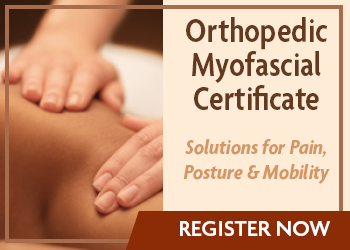 As the population ages, more people present stiffness as a key component of their physical limitations. How do we meet the demand for improved functional mobility with these patients? To accomplish this goal, therapists must enhance their skills for improving mobility using evidence-based techniques. Muscle energy techniques (MET) are advocated as part of a treatment plan to reduce abnormal muscle tension and to improve functional mobility. MET is a versatile intervention that may be employed to treat patients with neuromusculoskeletal conditions accompanied by limited joint range of motion. MET was initially described within the osteopathic profession by Drs. T.J. Ruddy1, and Fred Mitchell Sr2. During the same period, Knott and Voss were developing the Proprioceptive Neuromuscular Facilitation (PNF) Technique in physical therapy3. MET was later refined by Drs. Greenman4, Lewit5,6, Yale, Digiovanna7, Stiles1, and Goodridge1. Modern MET has been incorporated into multiple disciplines, including physical and occupational therapy, massage, chiropractic and personal training with the work of McAtee and Charland’s active stretching8 and Mattes’ Active Isolated Stretching (AIS)1. Dr. Leon Chaitow presents a contemporary overview of MET in his text, Muscle Energy Techniques1.
As the population ages, more people present stiffness as a key component of their physical limitations. How do we meet the demand for improved functional mobility with these patients? To accomplish this goal, therapists must enhance their skills for improving mobility using evidence-based techniques. Muscle energy techniques (MET) are advocated as part of a treatment plan to reduce abnormal muscle tension and to improve functional mobility. MET is a versatile intervention that may be employed to treat patients with neuromusculoskeletal conditions accompanied by limited joint range of motion. MET was initially described within the osteopathic profession by Drs. T.J. Ruddy1, and Fred Mitchell Sr2. During the same period, Knott and Voss were developing the Proprioceptive Neuromuscular Facilitation (PNF) Technique in physical therapy3. MET was later refined by Drs. Greenman4, Lewit5,6, Yale, Digiovanna7, Stiles1, and Goodridge1. Modern MET has been incorporated into multiple disciplines, including physical and occupational therapy, massage, chiropractic and personal training with the work of McAtee and Charland’s active stretching8 and Mattes’ Active Isolated Stretching (AIS)1. Dr. Leon Chaitow presents a contemporary overview of MET in his text, Muscle Energy Techniques1.
Clients often present with muscle spasm, painful trigger points, and limited range of motion. MET may be used to enhance outcomes of improved mobility and comfort for clients. Evidence based research indicates the value of MET in improving flexibility in clients of all ages, including rehab clients and the fragile elderly. Schiowitz reported that subjects with neck motion restrictions had a significant increase in cervical range of motion after treatment with MET, as compared to a sham control group10. Wilson, Payton, and Donegan-Shoaf reported a significant improvement in function and decrease in disability in patients with low back pain treated with MET compared to those treated with traditional exercise and neuromuscular re-education alone11. Contemporary muscle energy techniques are a part of interdisciplinary patient care, usually combined with manual therapy and exercise.
There are various stretching approaches described by MET practitioners. Each approach has its benefits. Most utilize the effect of post-isometric stretching, in which the involved short muscle (the agonist) is isometrically resisted, followed by passive or active stretching of the agonist by activation of the antagonist and/or passive movement by the practitioner. In PNF, this is known as contract-relax and hold-relax.1,3,8 Two types of MET have been described: post-isometric relaxation5,6 (PIR) and reciprocal inhibition.1(RI) In PIR, the short agonist muscle is activated with a gentle resisted isometric contraction for 2-10 seconds, followed by relaxation and passive stretching into the motion barrier within the tolerance of the client. The isometric contraction of the short agonist loads the proprioceptive Golgi Tendon Organ (GTO) within the agonist, causing a reflexive relaxation of the muscle. (GTOs inhibit contraction via the 1b afferent fibers to the spinal cord and efferent motor neuron.) After an active contraction, there is a short latency period within which the short agonist is inhibited. (In physiology, this is called the refractory period, which lasts about 15 seconds.1 Activation of the long antagonist also inhibits the short agonist by reciprocal inhibition, i.e.: when the flexors are activated, there is an automatic inhibition of the extensors by reflex action at the spinal cord level. It is useful to activate the antagonist during the stretch to take advantage of the relaxation response of reciprocal inhibition. Exhalation is often used during the stretching period to enhance the relaxation effect. If the client activates the long antagonist, the effect of the short agonist’s stretch reflex will also be reduced. The combination yields a significant increase in length of the agonist10.
Key features of effective MET stretches are the use of precise control of the joint being moved, specific resistance intensity to avoid damaging the muscle being stretched, and accurate timing of the stretch to begin after the short muscle has relaxed. MET has been shown to be effective in reduction of hypertonicity, increased range of motion, and reduction in disability and pain1.
The literature reflects that experts use different variations of MET. McAtee and Charland described the use of strong resisted isometric contractions, followed by active stretching by the client, typically in diagonal patterns8. One must be cautious when using strong contractions to avoid damaging to the muscle, especially after an injury. Gentler contraction forces are considered safer1. PNF uses varying intensities of contraction followed by passive or assisted stretching, using both diagonal and straight arc patterns of motion3,8. AIS uses breathing with repeated (1-2 seconds) isotonic contractions of the antagonist followed by patient-assisted stretching, exhaling while moving the joint through the barrier for 1-2 seconds and returning to neutral1. Caution must be used to avoid stretching too rapidly when using short duration contractions in severely involved individuals. Drs. Goodridge and Kuchera recommend using low intensity isometric contraction followed by passive stretching to minimize muscle guarding and delayed onset muscle soreness1. Each practitioner must determine the best method for their client based on the clinical presentation, type of restriction, tolerance of the client and desired outcome. With muscle guarding, simple PIR is effective to reduce contractile hypertonicity. With myofascial restrictions, additional passive stretching through the motion barrier is used and held for 90 seconds to allow the fasciae to lengthen. In most cases, forceful or ballistic stretching is avoided to reduce the incidence of microtrauma in the involved muscle.
To summarize, the steps to perform basic post-isometric relaxation MET with reciprocal inhibition are as follows:
- Position short muscle into a stretch or point of motion barrier
- Ask client to use 20%-50% intensity isometric contraction of the short muscle against your resistance
- Hold isometric contraction 3-10 secs. with a brief rest period of 2-3 secs.
- Provide passive or active assistive stretch a bit beyond the resistance barrier within the tolerance of the client.
- Practitioner may then ask client to activate the antagonist to move beyond the barrier into the greater range of motion.
- Perform 3-5 repetitions of the activity and reassess the range of motion, pain level, and function.
Case Report: Maggie is a 57 year old female school teacher with a diagnosis of plantar fasciitis and Achilles tendinitis onset 2 weeks ago due to walking in a fundraiser for 5 miles. (She is used to walking up to one mile daily, but does no other exercise.) She complains of pain upon weight-bearing on both feet, especially after prolonged sitting and upon awakening. Pain decreases once she is walking for 20 mins. She has custom orthotics for pronated feet, which she wears regularly. She is taking ibuprofen 400mg. for pain. Palpation reveals trigger points on both gastrocnemius heads bilaterally, calcaneii and plantar fascia, pain scale 8/10. Range of motion (ROM) is limited in ankle dorsiflexion from 0-10 degrees. Muscle strength is 3+/5 is bilateral plantarflexors. Gait is short in step length with early heel rise. Intervention consisted of myofascial release, massage and manual therapy to both feet and lower legs to improve circulation and relax musculature, muscle energy (contract-relax/PIR) to each gastroc/soleus complex 5 reps followed by full passive stretch with and without extended knees to increase ROM. ROM increased by 7 degrees in ankle dorsiflexion, pain reduced to 2/10 post-intervention. Outcomes were favorable on this initial visit. Client was instructed in home stretching and conditioning program and self-massage. Therapy will continue twice weekly for 3 weeks to achieve full ROM, normal strength, equal step length, and painfree feet.
Note: MET may result in some delayed onset muscle soreness (DOMS)14. Modify the force and position for each client based on their individual response. Clients may be instructed in the use of ice to diminish DOMS. MET has been shown to improve range of motion.15 Practitioners may teach clients to perform their own home programs of MET stretches. There are strengthening programs using MET as well as joint mobilization techniques using MET. For more information on MET, review the references provided at the end of this article. Chaitow offers the most comprehensive review of MET, including techniques which one may apply in practice. Review references by Drs. Fred Mitchell, Ed Stiles, Eileen DiGiovanna, and Stanley Schiowitz, and McAtee and Mattes for additional uses of MET. Live seminars and home study programs are also available. The versatility and clinical efficacy of MET makes it a valuable addition to rehabilitation programs for clients with neuromusculoskeletal conditions across the lifespan. Learn to master these skills to make stretching easy and improve outcomes for your practice.
References
- Chaitow, Leon, Muscle Energy Techniques, Second Edition, Edinburgh: Harcourt Publishers Limited, 2002
- Mitchell, UH, Myrer JW, Hopkins, JT, Hunter, I, Feland, JB, Hilton, SC, Acute Stretch Perception Alteration Contributes to the Success of the PNF “Contract-Relax” Stretch. Journal of Sport Rehabilitation,. 2007 May;16 (2):85-92
- Knott, Margaret, and Voss, Dorothy, Proprioceptive Neuromuscular Facilitation, Patterns and Techniques, Philadelphia: Harper and Row, 1968
- Greenman, Philip, Principles of Manual Medicine. Baltimore: Williams and Wilkins, 1996
- Lewit, K, Manipulative therapy in rehabilitation of the motor system, 3rd ed. Butterworths, London.
- Lewit, K, and Simons, D, Myofascial pain: relief by post isometric relaxation. Archives of Physical Medicine 1984; 65: 452-56.
- DiGiovanna, Eileen, D.O., and Schiowitz, D.O., An Osteopathic Approach To Diagnosis And Treatment. Philadelphia, Pennsylvania: J.B. Lippincott Company, 1991.
- McAtee, RE, and Charland, J, Facilitated Stretching: Assisted and Unassisted PNF Stretching Made Easy. Champaign, Human Kinetics, 1999.
- Decicco, PV, Fisher, MM, The Effects of Proprioceptive Neuromuscular Facilitation Stretching on Shoulder Range of Motion in Overhead Athletes. Journal of Sports Medicine and Physical Fitness, 2005 Jun;45(2):183-7.
- Burns, DK and Wells, MR, Gross range of motion in the cervical spine: the effects of osteopathic muscle energy technique in asymptomatic subjects. Journal of the American Osteopathic Association 2006;106(3):137-42.
11. Wilson, E, Payton, O, Donegan-Shoaf, L, Muscle energy technique in patients with acute low back pain: a pilot clinical trial. Journal of Orthopedic and Sports Physical Therapy. 2003;33(9):502-12.
12. Lim, K, Nam, YC, and Jung, K, Effects on Hamstring ,Muscle Extensibility, Muscle Activity, and Balance of Different Stretching Techniques. (2014) J Phys Ther Sci. Feb;26(2):209-213. Published u0online 2014 Feb 28. doi: 10.1589/jpts.26.209
13. Hiral, G, Tanvi, T, and Tarpan, S, Comparison of Post Isometric Relaxation Exercise and Static Stretching for Hamstring Tightness Normal Individuals Indian Jnl of Physical Therapy and Occupational Therapy- An International Journal.(2015);19(1):131-135.
14. McGrath, Ryan P.; Whitehead, James R.; and Caine, Dennis J. (2014) “The Effects of Proprioceptive Neuromuscular Facilitation Stretching on Post-Exercise Delayed Onset Muscle Soreness in Young Adults,”International Journal of Exercise Science: Vol. 7: Iss. 1, Article 3.Available at: http://digitalcommons.wku.edu/ijes/vol7/iss1/3. Accessed May 17, 2015
15. Rathore, P, Garnawat, D, Sharma, M, Panjee, K, and Aggarawal, T. (2014) Duration of Maintained Hamstring Flexibility Gains after a One-time, Modified Hold-Relax Stretching Protocol in Females. 15. Rathore, P, Garnawat, D, Sharma, M, Indian Jnl of PT. Vol 2(1) 2014 From: http://indianjournalofphysicaltherapy.in/ojs/index.php/IJPT/article/view/24. Accessed May 17, 2015.

